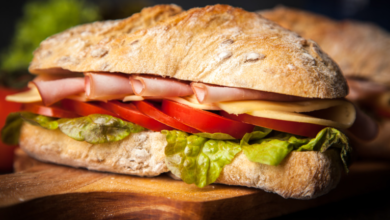Smart Choice Between Cornbread Vs Cornpone: An Expert Opinion
What To Know
- Cornbread is typically baked in a cast-iron skillet or a baking pan.
- Cornbread became a staple food in the Southern United States, where it is often served as an accompaniment to meals such as fried chicken and collard greens.
- Cornbread offers a light and fluffy texture with a sweet flavor, while cornpone provides a denser and more savory experience.
Cornbread and cornpone, two quintessential Southern delicacies, share a common ingredient: cornmeal. However, these two culinary creations differ significantly in texture, flavor, and preparation methods. Let’s delve into their distinct characteristics and unravel the mystery behind their contrasting identities.
Texture: A Tale of Two Breads
Cornbread, as its name suggests, is a bread-like delicacy with a crumbly texture. It is typically made with a combination of cornmeal, flour, and baking powder or soda. The resulting loaf is light and airy, with a slightly crispy exterior.
Cornpone, on the other hand, is a denser and more rustic bread. It is made with a higher proportion of cornmeal and no flour. This results in a coarser texture, with a chewy and slightly gritty interior.
Flavor: Sweet vs. Savory
Cornbread often leans towards a sweeter flavor profile, thanks to the addition of sugar or honey to the batter. It can also be enhanced with spices like cinnamon or nutmeg, giving it a warm and comforting flavor.
Cornpone, in contrast, is typically savory. It may be seasoned with salt, pepper, or other herbs and spices, such as chili powder or cumin. This creates a robust and earthy flavor that pairs well with hearty dishes.
Preparation: Two Paths to Perfection
Cornbread is typically baked in a cast-iron skillet or a baking pan. The batter is poured into the greased pan and baked until it rises and becomes golden brown.
Cornpone, on the other hand, is cooked in a skillet or griddle. The batter is spooned onto the hot surface and cooked until it forms a crust on both sides. This method results in a flatter and more compact bread.
Origins and Cultural Significance
Cornbread has its roots in Native American cuisine, where it was originally made with ground cornmeal and water. Over time, European settlers adopted the recipe and added ingredients like flour, sugar, and milk. Cornbread became a staple food in the Southern United States, where it is often served as an accompaniment to meals such as fried chicken and collard greens.
Cornpone, on the other hand, is believed to have originated in the Appalachian region of the United States. It was a simple and inexpensive bread that was often made by pioneers and farmers using the cornmeal they grew themselves. Cornpone is still enjoyed in many rural areas of the South and is often associated with traditional Southern cooking.
Cornbread vs. Cornpone: Which One Reigns Supreme?
Ultimately, the choice between cornbread and cornpone comes down to personal preference. Cornbread offers a light and fluffy texture with a sweet flavor, while cornpone provides a denser and more savory experience. Both breads have their place in Southern cuisine and are sure to satisfy any cornmeal craving.
The Ultimate Showdown: A Side-by-Side Comparison
| Characteristic | Cornbread | Cornpone |
| — | — | — |
| Texture | Crumbly, light, and airy | Dense, chewy, and gritty |
| Flavor | Sweet, with hints of spice | Savory, with earthy undertones |
| Preparation | Baked in a skillet or baking pan | Cooked in a skillet or griddle |
| Origins | Native American cuisine | Appalachian region of the United States |
| Cultural Significance | Staple food in the Southern US | Associated with traditional Southern cooking |
Final Thoughts: A Cornucopia of Choices
Whether you prefer the fluffy sweetness of cornbread or the rustic savoriness of cornpone, one thing is for certain: these two cornmeal creations are culinary treasures that embody the rich and diverse flavors of the American South. So next time you’re craving a comforting and delicious bread, consider exploring the world of cornbread and cornpone. You’re sure to find a loaf that will warm your heart and satisfy your taste buds.
Quick Answers to Your FAQs
1. Can I substitute cornmeal for flour in cornbread?
Yes, you can substitute cornmeal for flour in cornbread, but keep in mind that the texture will be denser and less fluffy.
2. What is the difference between white cornmeal and yellow cornmeal?
White cornmeal is made from white corn, while yellow cornmeal is made from yellow corn. White cornmeal has a milder flavor and a finer texture, while yellow cornmeal has a more robust flavor and a coarser texture.
3. Can I make cornbread without milk?
Yes, you can make cornbread without milk. You can substitute milk with buttermilk, yogurt, or even water.
4. How do I store cornbread?
Cornbread can be stored in an airtight container at room temperature for up to 3 days. It can also be frozen for up to 2 months.
5. What are some popular variations of cornbread?
Popular variations of cornbread include Jiffy cornbread, skillet cornbread, and spoonbread.
